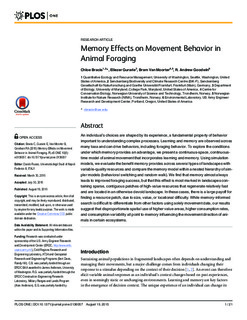Memory effects on movement behavior in animal foraging
Journal article
Permanent lenke
http://hdl.handle.net/11250/2372645Utgivelsesdato
2015Metadata
Vis full innførselSamlinger
- Institutt for biologi [2573]
- Publikasjoner fra CRIStin - NTNU [38070]
Sammendrag
An individual’s choices are shaped by its experience, a fundamental property of behavior important to understanding complex processes. Learning and memory are observed across many taxa and can drive behaviors, including foraging behavior. To explore the conditions under which memory provides an advantage, we present a continuous-space, continuous-time model of animal movement that incorporates learning and memory. Using simulation models, we evaluate the benefit memory provides across several types of landscapes with variable-quality resources and compare the memory model within a nested hierarchy of simpler models (behavioral switching and random walk). We find that memory almost always leads to improved foraging success, but that this effect is most marked in landscapes containing sparse, contiguous patches of high-value resources that regenerate relatively fast and are located in an otherwise devoid landscape. In these cases, there is a large payoff for finding a resource patch, due to size, value, or locational difficulty. While memory-informed search is difficult to differentiate from other factors using solely movement data, our results suggest that disproportionate spatial use of higher value areas, higher consumption rates, and consumption variability all point to memory influencing the movement direction of animals in certain ecosystems.
